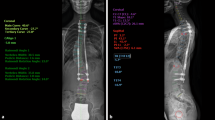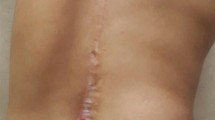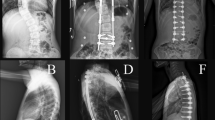Abstract
Purpose
To study the results and complications of Traditional Growing Rods (TGR) for the treatment of Early-Onset Scoliosis (EOS) in patients with Ehlers-Danlos syndrome (EDS).
Methods
This is a retrospective study of patients with EDS treated for EOS between 2012 and 2018 by TGR. For each patient, we evaluated the evolution of the Cobb angle of the main coronal curve before the first surgery, postoperatively and at the last follow-up. We also noted every complication.
Results
Four patients have been evaluated. Age at the index surgery ranged from 3- to 6-year-old. All the patients had a Kyphoscoliosis. The preoperative Cobb angle of the main coronal curve ranged from 70° to 104°. Prior to surgery, a progressive correction of the spinal deformity by Halo-gravity traction was performed for all patients. One patient had several complications with a poor result after final fusion. Three patients did not sustain any complication and presented good results. Follow-up ranged from 3 to 8 years. For two of our patients, further lengthening procedures are still needed.
Conclusions
TGR is a good surgical option for the treatment of EOS in EDS. A progressive preoperative correction is recommended. Anchor-related complications must be minimized in these patients with an important kyphosis.
Level of evidence
Level IV.


Similar content being viewed by others
References
Malfait F, Castori M, Francomano CA, Giunta C, Kosho T, Byers PH (2020) The Ehlers-Danlos syndromes. Nat Rev Dis Primers 6:64. https://doi.org/10.1038/s41572-020-0194-9
Malfait F, Francomano C, Byers P, Belmont J, Berglund B, Black J et al (2017) The 2017 international classification of the Ehlers-Danlos syndromes. Am J Med Genet C Semin Med Genet 175:8–26. https://doi.org/10.1002/ajmg.c.31552
Shirley ED, DeMaio M, Bodurtha J (2012) Ehlers-Danlos syndrome in orthopaedics: etiology, diagnosis, and treatment implications. Sports Health 4:394–403. https://doi.org/10.1177/1941738112452385
McMASTER M (1994) Spinal deformity in Ehlers-Danlos syndrome five patients treated by spinal fusion. J Bone Joint Surg Br 76:773–777
Vogel L, Lubicky J (1996) Neurologic and vascular complications of scoliosis surgery in patients with Ehlers-Danlos syndrome. A case report. Spine (Phila Pa 1976) 21:2508–2514
Yang JS, Sponseller PD, Yazici M, Johnston CE (2009) Vascular complications from anterior spine surgery in three patients with Ehlers-Danlos syndrome. Spine 34:E153–E157. https://doi.org/10.1097/BRS.0b013e31818d58da
Cheung JPY, Yiu K, Kwan K, Cheung KMC (2019) Mean 6-year follow-up of magnetically controlled growing rod patients with early onset scoliosis: a glimpse of what happens to graduates. Neurosurgery 84:1112–1123. https://doi.org/10.1093/neuros/nyy270
Akbarnia BA, Breakwell LM, Marks DS, McCarthy RE, Thompson AG, Canale SK et al (2008) Dual growing rod technique followed for three to eleven years until final fusion: the effect of frequency of lengthening. Spine (Phila Pa 1976) 33:984–990
Rohrbach M, Vandersteen A, Yiş U, Serdaroglu G, Ataman E, Chopra M et al (2011) Phenotypic variability of the kyphoscoliotic type of Ehlers-Danlos syndrome (EDS VIA): clinical, molecular and biochemical delineation. Orphanet J Rare Dis 6:46. https://doi.org/10.1186/1750-1172-6-46
Giunta C, Baumann M, Fauth C, Lindert U, Abdalla EM, Brady AF et al (2018) A cohort of 17 patients with kyphoscoliotic Ehlers-Danlos syndrome caused by biallelic mutations in FKBP14: expansion of the clinical and mutational spectrum and description of the natural history. Genet Med 20:42–54. https://doi.org/10.1038/gim.2017.70
Jasiewicz B, Potaczek T, Tesiorowski M, Lokas K (2010) Spine deformities in patients with Ehlers-Danlos syndrome, type IV—late results of surgical treatment. Scoliosis 5:26. https://doi.org/10.1186/1748-7161-5-26
Akpinar S, Gogus A, Talu U, Hamzaoglu A, Dikici F (2003) Surgical management of the spinal deformity in Ehlers-Danlos syndrome type VI. Eur Spine J 12:135–140. https://doi.org/10.1007/s00586-002-0507-6
Natarajan D, Samartzis D, Wong Y-W, Luk KDK, Cheung KMC (2011) Natural history of spinal deformity in a patient with Ehlers-Danlos syndrome: case report with 20-year follow-up. Spine J 11:e1-4. https://doi.org/10.1016/j.spinee.2011.02.029
Rabenhorst BM, Garg S, Herring JA (2012) Posterior spinal fusion in patients with Ehlers-Danlos syndrome: a report of six cases. J Child Orthop 6:131–136. https://doi.org/10.1007/s11832-012-0393-3
Teoh KH, Winson DMG, James SH, Jones A, Howes J, Davies PR et al (2016) Magnetic controlled growing rods for early-onset scoliosis: a 4-year follow-up. Spine J 16:S34–S39. https://doi.org/10.1016/j.spinee.2015.12.098
Working ZM, Hsiao M, Sanders JC, Bratton SL, D’Astous JL (2017) Spontaneous fatal intraoperative rupture of great vessel during growing rod lengthening: do children with Ehlers-Danlos syndrome require the availability of vascular expertise? A case report and review of the literature. J Pediatr Orthop 37:e4-9. https://doi.org/10.1097/BPO.0000000000000656
McFarland W, Fuller DE (1964) Mortality in Ehlers-Danlos syndrome due to spontaneous rupture of large arteries. N Engl J Med 271:1309–1310. https://doi.org/10.1056/NEJM196412172712508
Iyer S, Duah HO, Wulff I, Osei Tutu H, Mahmud R, Yankey KP et al (2019) The use of halo gravity traction in the treatment of severe early onset spinal deformity. Spine (Phila Pa 1976) 44:E841–E845. https://doi.org/10.1097/BRS.0000000000002997
el-Shaker M, Watts HG (1991) Acute brachial plexus neuropathy secondary to halo-gravity traction in a patient with Ehlers-Danlos syndrome. Spine (Phila Pa 1976) 16:385–386. https://doi.org/10.1097/00007632-199103000-00029
Thompson GH, Akbarnia BA, Kostial P, Poe-Kochert C, Armstrong DG, Roh J et al (2005) Comparison of single and dual growing rod techniques followed through definitive surgery: a preliminary study. Spine (Phila Pa 1976) 30:2039–2044. https://doi.org/10.1097/01.brs.0000179082.92712.89
Jones GA, Kayanja M, Milks R, Lieberman I (2008) Biomechanical characteristics of hybrid hook-screw constructs in short-segment thoracic fixation. Spine (Phila Pa 1976) 33:173–177. https://doi.org/10.1097/BRS.0b013e31816044b6
Mahar AT, Bagheri R, Oka R, Kostial P, Akbarnia BA (2008) Biomechanical comparison of different anchors (foundations) for the pediatric dual growing rod technique. Spine J 8:933–939. https://doi.org/10.1016/j.spinee.2007.10.031
Harris L, Andras LM, Mundis GM, Sponseller PD, Emans JB, Growing Spine Study Group et al (2020) Five or more proximal anchors and including upper end vertebra protects against reoperation in distraction-based growing rods. Spine Deform 8:781–786. https://doi.org/10.1007/s43390-020-00064-x
Funding
This study received no specific grant from any funding agency in the public, commercial, or not-for-profit sectors.
Author information
Authors and Affiliations
Contributions
MLT: substantial contributions to the conception and design of the work. Drafting the work or revising it critically for important intellectual content. Final approval of the version to be published. Agreement to be accountable for all aspects of the work in ensuring that questions related to the accuracy or integrity of any part of the work are appropriately investigated and resolved. AAM: Substantial contributions to the conception and design of the work. Revising it critically for important intellectual content. Final approval of the version to be published. Agreement to be accountable for all aspects of the work in ensuring that questions related to the accuracy or integrity of any part of the work are appropriately investigated and resolved. MNN: Substantial contributions to the conception and design of the work. Revising it critically for important intellectual content; and Final approval of the version to be published; and Agreement to be accountable for all aspects of the work in ensuring that questions related to the accuracy or integrity of any part of the work are appropriately investigated and resolved. RB: Substantial contributions to the conception of the work. Revising it critically for important intellectual content. Final approval of the version to be published. Agreement to be accountable for all aspects of the work in ensuring that questions related to the accuracy or integrity of any part of the work are appropriately investigated and resolved. HY-Y: Substantial contributions to the conception and design of the work. Revising it critically for important intellectual content. Final approval of the version to be published. Agreement to be accountable for all aspects of the work in ensuring that questions related to the accuracy or integrity of any part of the work are appropriately investigated and resolved. SB: Substantial contributions to the conception and design of the work. Revising it critically for important intellectual content. Final approval of the version to be published. Agreement to be accountable for all aspects of the work in ensuring that questions related to the accuracy or integrity of any part of the work are appropriately investigated and resolved.
Corresponding author
Ethics declarations
Conflict of interest
The authors declare no competing interest.
Informed consent
Informed consent was obtained from all individual participants involved in the study.
Ethical approval
All procedures performed in this study involving human participants were in accordance with the ethical standards of the institutional and national research committees.
Additional information
Publisher's Note
Springer Nature remains neutral with regard to jurisdictional claims in published maps and institutional affiliations.
Rights and permissions
Springer Nature or its licensor holds exclusive rights to this article under a publishing agreement with the author(s) or other rightsholder(s); author self-archiving of the accepted manuscript version of this article is solely governed by the terms of such publishing agreement and applicable law.
About this article
Cite this article
Toumia, M.L., Mohseni, A.A., Nessib, M.N. et al. Growing rods for early-onset scoliosis in Ehlers-Danlos disease. Spine Deform 11, 237–242 (2023). https://doi.org/10.1007/s43390-022-00580-y
Received:
Accepted:
Published:
Issue Date:
DOI: https://doi.org/10.1007/s43390-022-00580-y




